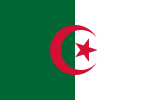| Part of a series on the |
| Culture of Algeria |
|---|
 |
| People |
| Mythology |
| Art |
The national symbols of Algeria are official and unofficial flags, icons or cultural expressions that are emblematic, representative or otherwise characteristic of Algeria and of its culture.



